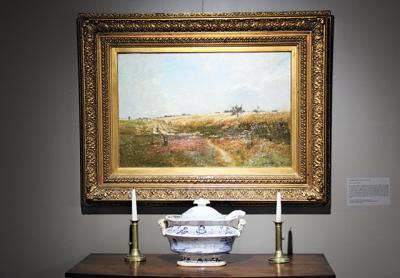Peaceful Scenes of Yesteryear at Clinton Academy

If you are among those who are frustrated by the crowds and noise of summer (and who isn’t?) the East Hampton Historical Society exhibition now at Clinton Academy offers a chance to reflect on simpler times.
“Caught on Canvas: Eastern Long Island Landscapes from the Wallace Collection, 1850-1935” includes some 40 works owned by the longtime East Hampton art dealer Terry Wallace that depict sylvan idylls, thinly populated if at all. Mr. Wallace recently promised to donate a number of his paintings, while the society has purchased others with funds from the Robert D. L. Gardiner Foundation.
Some of the paintings are charmingly naive; others are masterful and downright dazzling. The show is a reminder that there always have been talented artists who have fallen through the cracks, known only to those who specialize in their eras or genres.
According to Richard Barons, who is the historical society’s curator, “The Wallace material will form the core of a collection of local paintings, drawings, and graphics that will range in date from 1860 to 1940.” They will be displayed at the Gardiner Mill Cottage, which is being restored by the Village of East Hampton and will become a museum focusing on the early artists here.
The serene and simpler times seen on the canvases, which are sometimes tinged with the somber palette of the “Brown Decades” following the Civil War, encourage a contemplative and measured assessment of the world around us, a renewed appreciation for the pure natural beauty that attracted people here in the first place.
One look at Edward Lamson Henry’s “Waiting for the Bathers: Indian Wells Beach,” from 1879, which is the show’s centerpiece, sends the mind on a mini-vacation. Its nearly abandoned beach, save for a couple picnicking under an umbrella and the skeletal remains of what is probably the Catherine, an 1850 shipwreck, which still resurfaces after hurricanes, offers some solace to those who continue to be rankled by the drunken revels of recent summers at that very site.
The sky the artist captures is familiar to South Fork residents: a low-lying haze across the water, which could drift in by nightfall, and broken clouds that leave a gaping hole through which a concentrated spotlight of sunshine falls directly on the subjects.
It may seem hokey and staged, but it easily could have been the truth of that moment, a resplendent pause in an overcast sky. It is clear why this painting is the centerpiece; it introduces the strange sameness of certain elements that have been otherwise greatly altered.
Yoked, horned bovines pulling a cart down a dune are among the many long-gone sights and scenes. Carts once carried seaweed to the village for use as insulation. Dating from the turn of the century, Hamilton Hamilton’s painting is a testament to how enduring that practice was and why homeowners still find seaweed in the walls of some old houses when renovating.
In another scene, horses draw a cart carrying a coffin down Main Street in Southampton. Edgar Jefferson Taylor’s somber colors fit the subject, but also show the influence of Thomas Eakins, with whom he studied at the Pennsylvania Academy of Fine Arts. Dating from 1894, the landscape has a blocky quality and a massing of the horses‘ anatomy that recalls Cézanne. Although no one has identified the event in the scene, there is some speculation that the draped coffin may have held a member the Shinnecock Indian Tribe.
More often, scenes are of sailboats and ships, fields and pastures, trees and farm buildings. Very few artists in the show lived here, according to Mr. Barons. They had visited from the city and even farther away, from places like Baltimore, Charleston, and even Oxford, England. They had often trained in academies, including William Merritt Chase’s Shinnecock Summer School, and in New York City and European art capitals.
The influences of well-known artists are apparent: Winslow Homer, Childe Hassam, Corot, the early-19th-century Barbizon School painters, and Thomas and Mary Nimmo Moran. The Moran family itself is represented by Edward Moran, Thomas’s brother, and John Leon Moran, Edward’s son.
Mr. Barons promised changing exhibitions at the cottage that will have themes related to subject matter such as dunes, mills, and streetscapes. In addition, some shows will focus on some of the lesser-known artists who came here to paint. The Wallace collection will remain on view at Clinton Academy through July 23.
